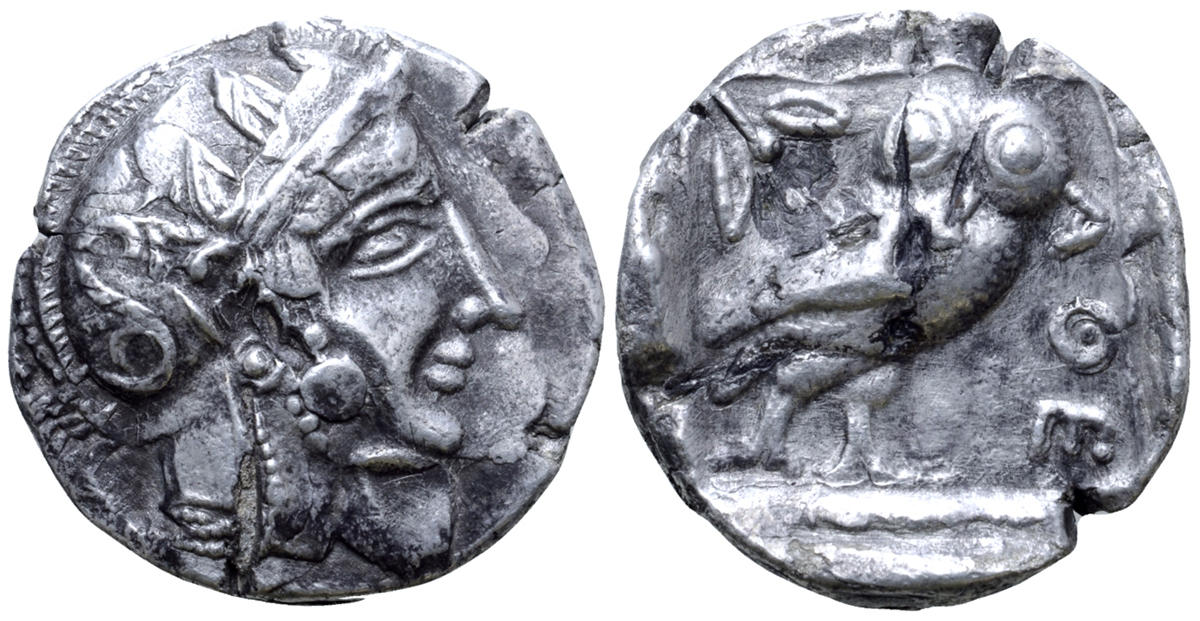SO 548 - Athens over Athens
From SILVER
390 BCE - 295 BCE | AΘE
Images
Overstriking coin

Athenes_sur_Athenes_Roma88.jpg [1]
Location/history
| Sale(s)Sale(s) ᵖ: | Roma Numismatics, E-live auction 3, 25 Oct. 2018, 88. | |
Overstriking coin
Description
| ObverseInscription or printing placed on the obverse.: | Head of Athena right, wearing crested Attic helmet. Border of dots. | ReverseInscription or printing placed on the reverse.: | AΘE Owl right. Behind, olive spring and cescent. |
Mint and issuing power
| MintIdentifies the place of manufacture or issue of a numismatic object.: | Athens | Ancient regionAncient region. | Attica | Modern countryModern country: Greece | AuthorityIdentifies the issuing power. The authority can be "pretended" when the name or the portrait of X is on the coin but he/she was not the issuing power. It can also be "uncertain" when there is no mention of X on the coin but he/she was the issuing power according to the historical sources: |
Chronology
| FromIdentifies the initial date in a range assigned in a numismatic context. 390 BCE toIdentifies the final date in a range assigned in a numismatic context.. 295 BCE | Classical 480-323 BC |
Physical description
| MetalThe physical material (usually metal) from which an object is made.: Silver |
WeightWeight of the numismatic object (in grams). in grams: 15.115.1 g <br />15,100 mg <br /> | DenominationTerm indicating the value of a numismatic object. Examples: tetradrachm, chalkous, denarius.: tetradrachm |
AxisDescribes the directional relationship between the obverse and reverse of a numismatic object.: 99 mm <br />0.9 cm <br /> |
| DiameterDescribes diameter of an object (in mm).: 2424 mm <br />2.4 cm <br /> | StandardStandard.: Attic | ||
References
| Coin referenceReference of the Coin: | https://www.acsearch.info/search.html?id=5373103 | Coin series referenceReference to coin series study: | SNG Copenhagen 31SNG Copenhagen 3, n°64, Kroll 19932Kroll 1993, n°15, Flament 20073Flament 2007, Pi-style, HGC 44HGC 4, n°1595-1597 |
| Coin series web referenceCoin series web references: | |||
Overstruck type
Description
| ObverseInscription or printing placed on the obverse.: | Head of Athena. | ReverseInscription or printing placed on the reverse.: | Owl. |
Mint and issuing power
| MintIdentifies the place of manufacture or issue of a numismatic object. ᵖ: | Athens | Ancient regionAncient region. ᵖ | Attica | Modern countryModern country: Greece | AuthorityIdentifies the authority in whose name (explicitly or implicitly) a numismatic object was issued. ᵖ: |
Chronology
| FromIdentifies the initial date in a range assigned in a numismatic context. toIdentifies the final date in a range assigned in a numismatic context.. | periodTime period of the numismatic object. |
Physical description
| DenominationTerm indicating the value of a numismatic object. Examples: tetradrachm, chalkous, denarius. ᵖ: | tetradrachm |
StandardStandard. ᵖ: | Attic |
References
| Coin type referenceReference to coin series study ᵖ: |
Additional data
| Frequency of overstrikesFrequency of overstrikes: | frequent | Level of confidenceLevel of confidence of the identification: | strong |
| RemarksRemarks: | "Overstruck. Clear evidence of the overstruck nature of this coin can be seen in the rounded and pointed olive leaves visible above the helmet visor, and the shadow of nose and chin in the obverse right field." | ||